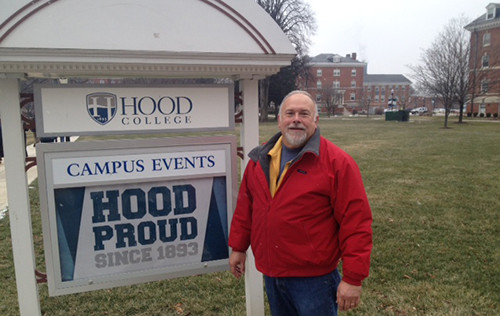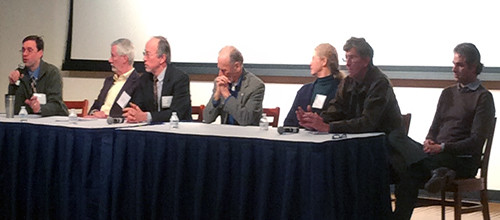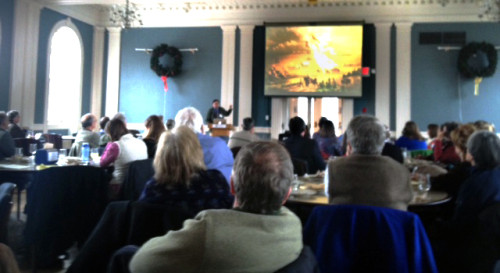Growth and the future of Chesapeake Bay conference at Hood College
Bill Dennison ·I attended a two-day workshop on January 13-14 held at Hood College in Frederick, Maryland. It was organized by Tom Horton and Karl Blankenship and sponsored by Town Creek Foundation and the Bay Journal. Roughly 150 people gathered for these two days to talk about an issue that we generally do not talk about regarding Chesapeake Bay: population growth. Population growth has been an issue that Tom Horton, the prolific Chesapeake author and activist, has been advocating for some time. Tom's second edition of "Turning the Tide: Saving the Chesapeake Bay" brought up this issue in 2003.
Tom kicked off the conference with a series of spectacular photographs by his talented colleague, the Chesapeake photographer David Harp. Then a series of talks, largely by authors of relevant books, and panels by local people and questions/answers by audience completely occupied our time. Apart from the walk across the Hood College campus to our lunch venue, we had speakers and panels throughout, including during lunch and breaks. The speakers and panelists tended toward white males, partly due to some speakers who were "dis-invited" to avoid derailing the conference theme, but we really should have more women involved in discussions about population. I enjoyed "Vasecto-Man" (Richard Ochs) who was dressed as a superhero complete with a purple cape who sang some clever songs during lunch.
As part of my role on the summary panel, I wrote the following poem:
Growth and the future of Chesapeake Bay
William C. Dennison
Thanks to Drew Ferrier1 for this nice Hood College venue
So that Tom Horton could gather me and all of you
To inject population and growth into our Chesapeake conversation
With the hopes of making progress on Chesapeake restoration.

Richard Heinberg2 talked about energy, debt and climate
While Eben Fodor3 showed that growth does not rate
When considering income, unemployment and poverty
And Peter Victor4 told us that money alone does not make us happy.
Herman Daly5, of ecological economics fame, showed us that the world is now full
And gave us a series of recommendations that would make us all whole
Over lunch, Brian Czech6 introduced us to the 800 pound gorilla
Later on, Ramon Palencia7 told us how our population is becoming less vanilla.
We had a panel of scientists speak up for all the fish
Scott8, Bob9, Jim10 and Dennis11 told us what the fish all wish
Less people, less imperviousness and less nasty Phrag
Those things would make stream health less of a drag.

We also had a panel address population from a local view
This panel included Greg12, Elliot13, Tom14 and the lone woman Dru15
We heard about efforts in Maryland and Virginia counties to set a max
And we heard about a Genuine Progress Indicator and the controversial rain tax.
Rob Dietz16 told us a scary story about his little daughter
Linking to lessons about food, land and water
Bill Ryerson17 had a compelling story of using a wide media range
And invoking soap opera emotions to catalyze social change.
Tom Horton addressed the immigration issue--making it vocal
Bob Engleman18 told us that population is all local
And that pregnancies are often not what women want
And then George Plumb19 gave us a vision for a sustainable Vermont.
At lunch, we enjoyed a Vasecto-Man20 serenade
And Tom Butler21 showed us a slide parade
Tom, an unapologetic tree hugger, challenged our rhetoric
Encouraging us to become more ecologic.

Nancy Wallace22 has tackled the population perception
With lobbying campaigns and male contraception
Throughout the conference there was lots of audience participation
Town Creek once again provoked an important conversation
The summary panel included Bill23, Peyton24, Nick25, Ann26 and Tom27
They talked about their approaches to the population bomb
They introduced frozen peas, glasses half full, and report cards for the Bay
And then the audience once again had their say.
So what did we learn from these two days in Frederick
We learned that the mantra "All growth is good" makes societies sick
We heard from lots of people who are really quite smart
If we can embrace their ideas for Chesapeake, that would be a good start.
1 Drew Ferrier, Hood College
2 Richard Heinberg, author of "The end of growth: Why we won't be able to resume business as usual"
3 Eben Fodor, author of "Better not bigger: How to take control of urban growth and improve your community"
4 Peter Victor, author of "Managing without growth: Slower by design not disaster"
5 Herman Daly, author of "Steady-state economics"
6 Brian Czech, author of "Supply shock"
7 Ramon Palencia-Calvo, Maryland League of Conservation Voters
8 Scott Stranko, Maryland Department of Natural Resources
9 Bob Hilderbrand, Appalachian Laboratory, University of Maryland Center for Environmental Science
10 Jim Uphoff, Maryland Department of Natural Resources
11 Dennis Whigham, Smithsonian Environmental Research Center
12 Greg Bowen, Calvert County Department of Planning (retired)
13 Elliott Campbell, Maryland Department of Natural Resources
14 Tom Olivier, Advocates for a Sustainable Albemarle Population
15 Dru Schmidt-Perkins, 1000 Friends of Maryland
16 Rob Dietz, author of "Enough is enough: Building a sustainable economy in a finite world"
17 Bill Ryerson, The Population Institute
18 Bob Engelman, author of "More: Population, nature and what women want"
19 George Plumb, Vermonters for a Sustainable Population
20 Vasecto-Man, aka Richard Ochs
21 Tom Butler, author of "Wildlands philanthropy"
22 Nancy Wallace, former director of international population program, Sierra Club
23 Bill Dennison, University of Maryland Center for Environmental Science
24 Peyton Robertson, NOAA Chesapeake Bay Office
25 Nick DiPasquale, EPA Chesapeake Bay Program
26 Ann Swanson, Chesapeake Bay Commission
27 Tom Simpson, formerly Watershed Stewardship, Inc.
About the author
Bill Dennison

Dr. Bill Dennison is a Professor of Marine Science and Vice President for Science Application at the University of Maryland Center for Environmental Science.

